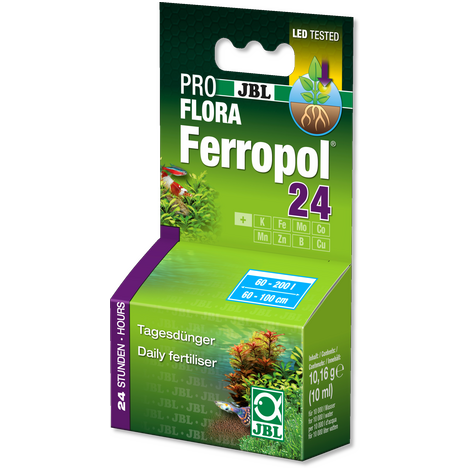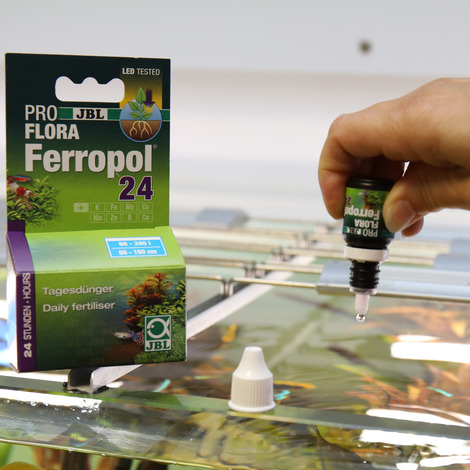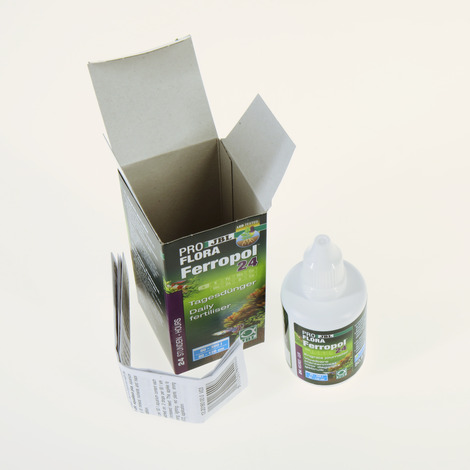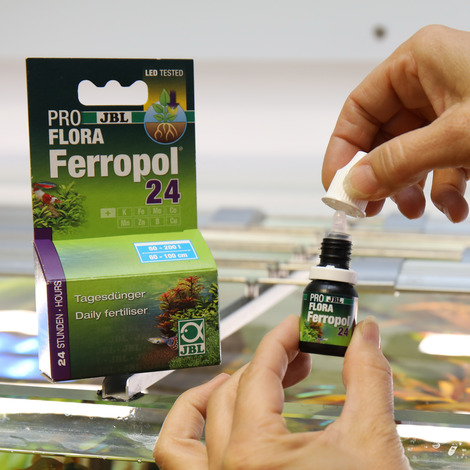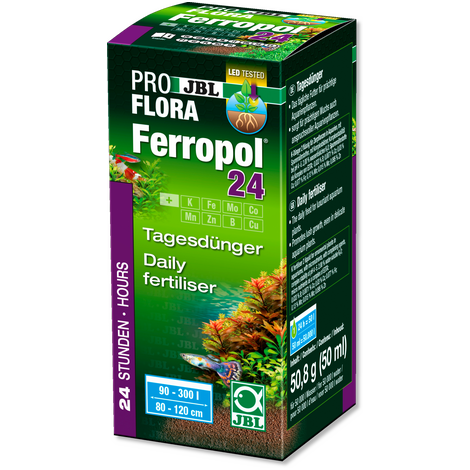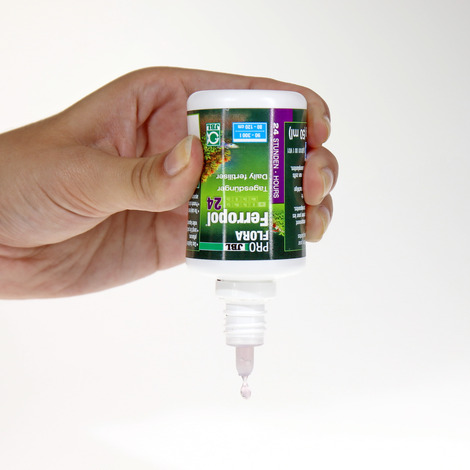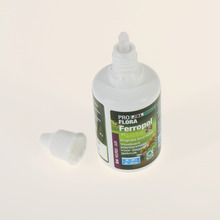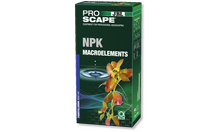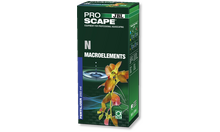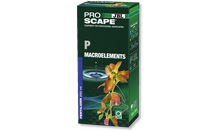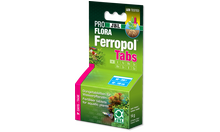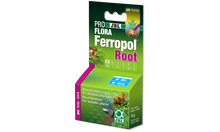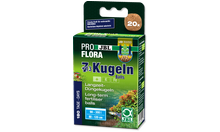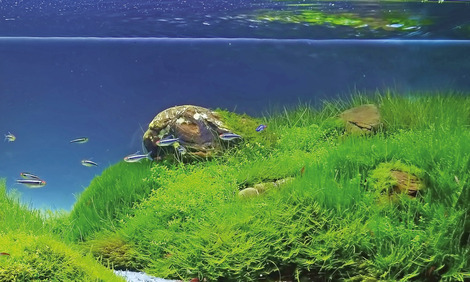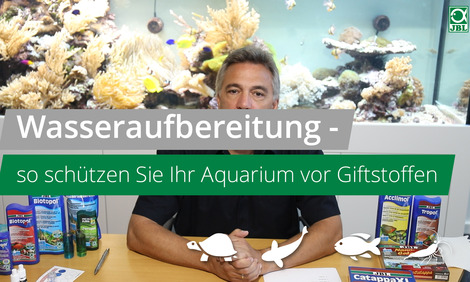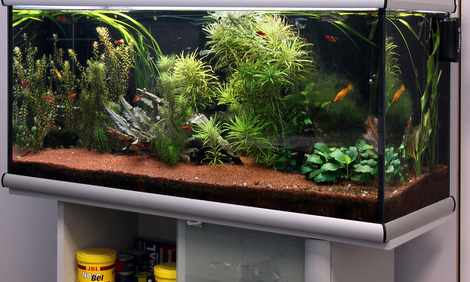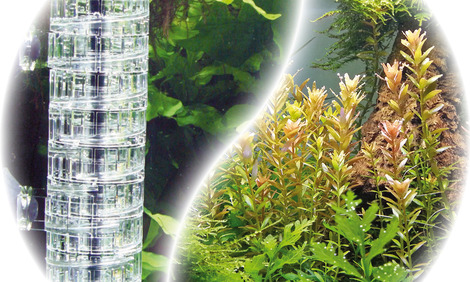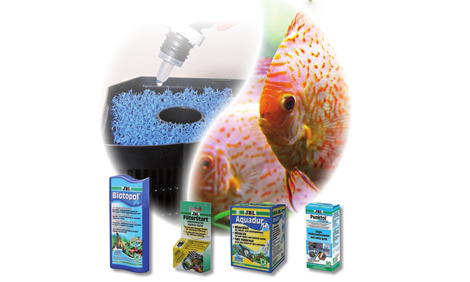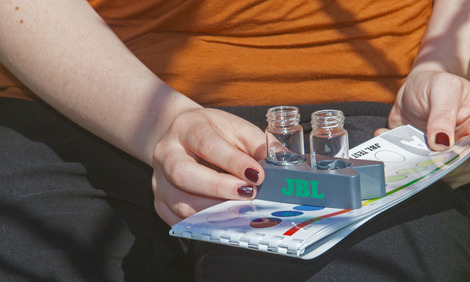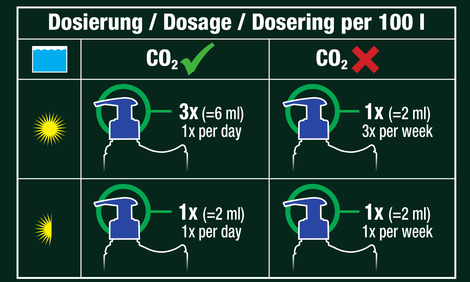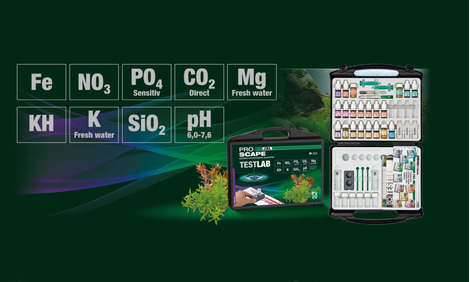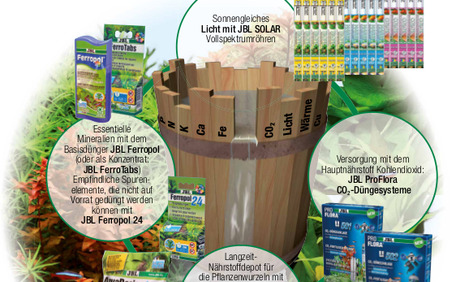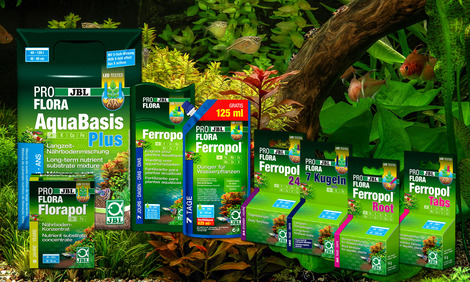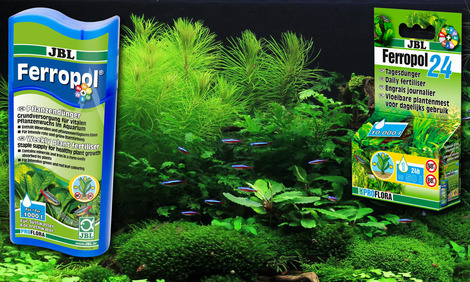Nutrition for aquarium plants
Healthy plants prevent algae growth, supply oxygen, remove pollutants, offer hiding places and reduce pathogens.
Heatlhy plants = healthy fish
For the plants to flourish the following demands have to be met:
light as an energy source for photosynthesis
CO2, nutrients and trace elements as growth promoters.
JBL fertilisers supply the plants with all main nutrients and essential trace elements. This way the plants can absorb all the required nutrients they need over the leaves and roots, and deficiency symptoms (e.g. iron deficiency) are thus prevented.
JBL PROFLORA Ferropol 24
Daily plant fertiliser for freshwater aquariums
- The daily feed for luxuriant aquarium plants: daily fertiliser for freshwater aquariums
- Optimum, targeted care, provides all vital trace elements which cannot be provided by long-term fertilisers
- Vigorous plant growth, no deficiency symptoms: optimal supply with essential trace elements
- Optimal promotion of plant growth means less algae growth. No phosphates and nitrates.
- Contents: 1 packet Ferropol 24. Use: 1 drop daily/50 l water
You may also be interested in
JBL PROFLORA Ferropol 24 10 ml
Properties
| Animal species: | Armored catfish, Arowana, Axolotl, Barbels, Bettas, Bichirs/reedfish, Blowfish, Catfish, Cichlids (South America), Clawed frogs, Clawed shrimps, Crayfish, Crustaceans, Danions, Discus, Dwarf crayfish, Dwarf shrimps, Flowerhorn, Gill maggots, Goldfish, Gouramis, Guppy, Juvenile fish, Killifish, Livebearers, Loaches, Mussels, Newts, Panchaxes, Rainbowfish, Snails, Spiny eels, Terrapins, Tetra, Tropical terrapin, Veiltails, Water turtles, blood parrot cichlids, freshwater butterflyfish |
| Animal size: | For all animal sizes |
| Animal age group: | All aquarium fish |
| Volume habitat: | 10,000 L |
| Material: | EDTA sodium salt, iron, aluminium, zinc, boron, manganese, copper, cobalt, potassium iodide, nickel, lithium, tin, bromine, purified water |
| Colour: | green |
| Dosage: | One drop JBL Ferropol 24 per 50 l aquarium content daily |
Electronic label / illuminant
| Mercury: | No |
| Dimmable: | No |
JBL PROFLORA Ferropol 24 50 ml
Properties
| Animal species: | Armored catfish, Arowana, Axolotl, Barbels, Bettas, Bichirs/reedfish, Blowfish, Catfish, Cichlids (South America), Clawed frogs, Clawed shrimps, Crayfish, Crustaceans, Danions, Discus, Dwarf crayfish, Dwarf shrimps, Flowerhorn, Gill maggots, Goldfish, Gouramis, Guppy, Juvenile fish, Killifish, Livebearers, Loaches, Mussels, Newts, Panchaxes, Rainbowfish, Snails, Spiny eels, Terrapins, Tetra, Tropical terrapin, Veiltails, Water turtles, blood parrot cichlids, freshwater butterflyfish |
| Animal size: | For all animal sizes |
| Animal age group: | All aquarium fish |
| Volume habitat: | 50,000 L |
| Material: | EDTA sodium salt, iron, aluminium, zinc, boron, manganese, copper, cobalt, potassium iodide, nickel, lithium, tin, bromine, purified water |
| Colour: | green |
| Dosage: | One drop JBL Ferropol 24 per 50 l aquarium content daily |
Electronic label / illuminant
| Mercury: | No |
| Dimmable: | No |
UVC light degrades the chelators in the fertilizers, which prevent the precipitation of trace elements such as iron, among others. Therefore, when using a UVC water clarifier, it is advisable to change over to daily fertilisation. The standard dose needs to be converted into a daily dose at the beginning. It may also be necessary to increase the fertiliser dose slightly. Iron should be detectable in traces at least prior to each subsequent application of fertiliser. Vitamins and other higher grade organic compounds may likewise be broken down. Therefore, when using vitamins, it is advisable to add the fertilizer with the food twice a week.
Algae problems in an aquarium can never be traced to just one factor or general condition, and instead, are always the result of a combination of different factors, which include light, fertilization, water changes – specifically, how often and how much – feeding, fish population and, of course, the specific water parameters.
According to analyses that were performed over a course of a number of years, red algae, at least the common brush algae and beard algae, occur in descending order at the following parameters:
1) too little carbon dioxide (in relationship to 100 % of the measured tank); the pH level should be in the slightly acetic range, depending on the carbonate hardness, in every case.
2) elevated phosphate levels (over 90 %); phosphate limitation by means of JBL PhosEx ultra is often helpful here.
3) too little and too irregular fertilization (there should always be traces of iron at least).
4) insufficient water changes; a weekly water change of over 30 % is recommended for algae problems.
5) not enough fast-growing plants.
Generally, one should never change plant fertilizers abruptly. The fertilizers from different manufacturers have somewhat different compositions in terms of trace elements. This may cause temporary nutrient changes. It is best to change over in 3 steps:
1) Reduction of the old fertilizer by 1/3; replace this with 1/3 of the new fertilizer. Wait approx. 3-4 weeks and observe the reaction of the plants.
2) Reduction of the old fertilizer by 2/3; replace this with 2/3 of the new fertilizer. Wait approx. 3-4 weeks and observe the reaction of the plants.
3) Complete discontinuation of the old fertilizer and change-over to the new fertilizer.
It is important to observe the reaction of plant growth and, in addition, to check the iron content of the water at least 2x weekly. Whereas the value should never drop to 0, it should never exceed 0.2 mg/l if possible. However, short peaks are no cause for concern.
These measures should generally be carried out on a weekly basis, ideally right after a water change. This achieves better results than fertilizing in large doses at longer intervals.
A comprehensive answer to this question cannot be provided, as this would require a comprehensive analysis of the water, the fertilisation, lighting and the carbon dioxide supply, plus regular water care.
Although algae can be attributed to an excess of nutrients - particularly phosphate and nitrate in this case, - in many cases, they are also the result of a lack of so-called micronutrients, of which iron is the best known. Very often, this is the deeper cause of the algae problem.
When algae growth occurs, it is generally highly advisable to increase the amount and frequency of water changes, make sure there is a sufficient supply of fast-growing plants and fertilise these with JBL Ferropol or JBL Ferropol 24 in accordance with the instructions.
1. Increase the volume of water changed each week to about 30-50%.
2. Fertilise regularly after each water change, e.g. with JBL Ferropol.
3. If necessary add a daily dose of Ferropol 24.
4. If algae promoting nutrients (especially phosphate) are present in higher quantities, use e.g. JBL PhosEx ultra to keep them under control.
5. Most important is carbon dioxide. Beard and brush algae are always a sign that there is too little carbon dioxide in the water. If a CO2 system is in use, increase its dosage. Alternatively consider installing a CO2 system like JBL ProFlora u401 or m601.
6. Put in fast growing stem plants as nutrient competitors.
7. If there is strong current, reduce it slightly.
All the ornamental plant fertilisers already mentioned contain copper, which is usual in good trace element fertilisers for aquariums. Copper is an essential trace element for plants and animals.
For shrimps, other decapods and some other animal groups copper is a central atom of the blood pigment haemocyanin, and thus essential for transporting oxygen inside the animal.
The concentration in JBL PROFLORA FERROPOL, JBL PROFLORA FERROPOL 24 und JBL ProScape Fe +Microelements is so designed that all trace elements are available in the required quantities. Not even multiple fertiliser overdosing can harm the shrimps and other decapods.
Reviews
0 Reviews
6 more reviews in other languages
6 Reviews in other languages
super daily fertilizer. complete with the co2 kit and the magic begins.
awesome ❤️
Prix honnête pour le résultat pour mes plantes d'aquarium ! Plus contraignant car il faut le mettre chaque jour mais plus efficace que l'autre ferropol à mettre chaque semaine. Je le recommande !
Pflanzen wachsen klasse und entwickeln tolle Farben
Ich bin sehr zufrieden mit dem Tagesdünger. Er ist einfach zu Dosieren.
Die Pflanzen wachsen gut und haben keine Mangelerscheinungen.
Niezawodny! Dla mnie zdrowie roślin i mieszkańców akwarium stoi na pierwszym miejscu . Nawóz zapewnia zdrową i silną roślinność dzięki czemu wszystko w zbiorniku funkcjonuje należycie, panuje równowaga a glony nie mają szansy rozwoju.
Ein Produkt mit einer sehr reichen Zusammensetzung, die die Entwicklung und den Zustand von Aquarienpflanzen unterstützt. Eine große Anzahl von Elementen in diesem Produkt ermöglicht es Ihnen, unsere Pflanzen einfach zu pflegen
